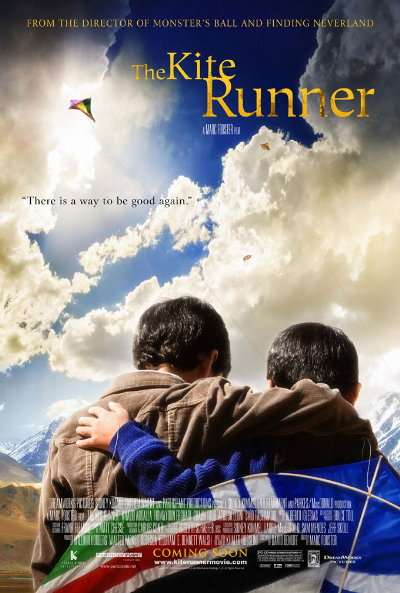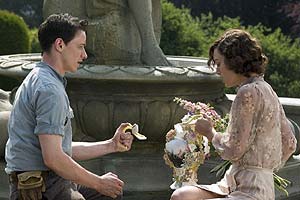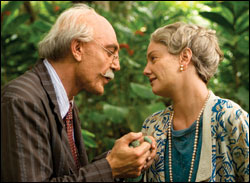“Everyone will kneel to you — if you will kneel to me.” That is the offer made by a gold-dusted, multi-pierced Xerxes of Persia to King Lionidas (Gerard Butler) of Sparta in this visually sumptuous version of the battle of Thermopylae.
If Lionidas is tempted it is not by the prospect of ruling over thousands of people he has never met. What makes him pause is the consequence of saying no. If he refuses to kneel to Xerxes, he and his 300 warriors will be slaughtered.
Would we still be making movies about them if he accepted Xerxes’ offer?
He said no. Actually, it was more like NO. The 300 Spartans fought as hard as they could until all of them were dead. Their skill and courage rallied their Greek countrymen to fight the Persians. And their passion for freedom has kept their story vital through the centuries.
This version is based on the graphic novel by Frank Miller (“The Dark Knight,” “Sin City”). Like his book, it explodes with stunning images of breathtaking power. Ironically, though, while in the book the still images are kinetic, on screen the moving images are sometimes static. On the page, we see very striking composition but have to imagine all that happens in between and we intuitively assign the interstitial material less intensity. But director Zach Snyder tries to take our breath away with every single shot and he has so many moments in slow- and stop-motion that the film would be half an hour shorter if everything ran at normal speed. The heavily stylized compositions, balletic, blood-gushing violence, and wave after wave of different styles of marauders at times feel more like a video game than a movie.
by Frank Miller (“The Dark Knight,” “Sin City”). Like his book, it explodes with stunning images of breathtaking power. Ironically, though, while in the book the still images are kinetic, on screen the moving images are sometimes static. On the page, we see very striking composition but have to imagine all that happens in between and we intuitively assign the interstitial material less intensity. But director Zach Snyder tries to take our breath away with every single shot and he has so many moments in slow- and stop-motion that the film would be half an hour shorter if everything ran at normal speed. The heavily stylized compositions, balletic, blood-gushing violence, and wave after wave of different styles of marauders at times feel more like a video game than a movie.
The images are undeniably stunning, though. Almost everything was done through computer effects, which means that anything was possible — elephants hurtling over a cliff, a giant warrior, a wall of bodies, arrows that, as promised by the Persians, blot out the sun, all in a burnished, gold-washed glow accented by the red of the Spartans’ cloaks.
The best that can be said of the acting and the dialogue is that they are not overly distracting. Ultimately, like Greece itself, the movie’s strength is based in the eternal pull of its story. Like the Alamo and Masada,
and Masada, the story of the 300 Spartans who died in the battle of Thermopylae reminds us of the dignity, honor, and meaning that can be drawn from the direst of circumstances. That these stories span thousands of years of history should remind us of our failure to honor the memories of those who have died by learning how to prevent the need for such sacrifices.
the story of the 300 Spartans who died in the battle of Thermopylae reminds us of the dignity, honor, and meaning that can be drawn from the direst of circumstances. That these stories span thousands of years of history should remind us of our failure to honor the memories of those who have died by learning how to prevent the need for such sacrifices.
What lessons do we learn? People on both sides have already begun to comment on the parallels between the story of Lionidas and Xerxes and the role of the United States in Iraq. But is America like the Spartans, standing up for freedom at whatever cost? Or are we the Persians, bringing our corrupt but mighty power to bear on a country that has a small fraction of our resources but many times our passion and staying power? What is most important is that retelling this story gives us an opportunity to ask those questions. This version gives us a lot to look at and more to think about.
Parents should know that this movie is filled with non-stop, extreme, and very graphic battle violence. Many, many limbs and heads are sliced off and many, many characters are wounded and killed. There are also some grotesque and graphic images of diseased and monstrous characters. There is some drinking and possible drug use, and there are are some sexual references (including homophobic insults and transgender characteristics as a sign of lack of integrity and honor) and some sexual situations, including an orgy, and some nudity. A man forces a woman to have sex and tells her that it will be painful.
Families who see this movie should talk about the concept of hubris in classical texts, the fatal mistake of placing oneself on the same level as the gods. They should talk about what mattered most to Lionidas and Gorgas, his wife. Did they make the right choices? What should Lionidas have said to Ephialtes? Why did Spartan woman tell their men to come back “with your shield or on it?” What do you think of the values of the Spartans? Are they barbaric? Why or why not? Theron calls himself a realist. What does that mean?
Families who want to know more about the history of this battle can begin with this essay by scholar Victor Davis Hanson, adapted from his introduction to the book about the making of the movie. They may want to take a look at the report of the battle by Herodotus. A 1962 movie with Richard Egan, The 300 Spartans , depicted this battle. And they may like to compare this film to Frank Miller’s graphic novel
, depicted this battle. And they may like to compare this film to Frank Miller’s graphic novel . The movie Go Tell the Spartans uses the battle of Thermopylae as a metaphor and counterpoint to the Vietnam war. A very different portrayal of Xerxes can be found in the Bible, where he is called Achashverosh, in the Book of Esther. Families who enjoy this film will also enjoy Gladiator
. The movie Go Tell the Spartans uses the battle of Thermopylae as a metaphor and counterpoint to the Vietnam war. A very different portrayal of Xerxes can be found in the Bible, where he is called Achashverosh, in the Book of Esther. Families who enjoy this film will also enjoy Gladiator .
.

puts a struggle for personal redemption and atonement in the context of devastating divides, ethnic, cultural, poltical, and moral, set in Afghanistan before, during, and after the Soviet invasion of 1979. Loyalty, betrayal, even identity itself are themes that echo and circle back on themselves in this moving story of learning what it means to “be good again.”


